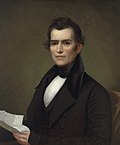Search results
Appearance
There is a page named "Pelham, Massachusetts" on Wikipedia
- Pelham is a town in Hampshire County, Massachusetts, United States. The population was 1,280 at the 2020 census. Its ZIP Code is shared with Amherst....13 KB (1,617 words) - 14:57, 2 May 2024
- neighborhood Pelham Parkway, Bronx, a neighborhood Pelham, Alabama Pelham, Georgia Pelham, Massachusetts Pelham, New Hampshire Pelham, North Carolina Pelham, Tennessee...2 KB (251 words) - 05:17, 24 May 2024
- Shays's Rebellion (category Pelham, Massachusetts)some of the merchants hostage. Lincoln pursued them and reached Pelham, Massachusetts on February 2, some 20 miles (32 km) from Petersham. He led his...45 KB (5,209 words) - 06:41, 27 June 2024
- up from 12,897 at the 2010 census. Pelham was split from Old Dunstable in 1741, when the border between Massachusetts and New Hampshire was settled. It...16 KB (1,489 words) - 17:03, 3 May 2024
- The Pelham Town Hall Historic District encompasses the remaining municipal portion of the center of Pelham, Massachusetts as laid out between 1738 and...4 KB (356 words) - 17:53, 22 June 2024
- William Otis (category People from Pelham, Massachusetts)first used on the Western Railroad in Massachusetts. Otis was born on September 20, 1813, in Pelham, Massachusetts. He was a cousin of Elisha Otis of elevator...4 KB (440 words) - 17:39, 8 June 2024
- secondary school in Amherst, Massachusetts, United States, for students in grades 9–12. It is part of the Amherst-Pelham Regional School District, which...11 KB (942 words) - 08:17, 19 June 2024
- H. W. Harkness (category People from Pelham, Massachusetts)Harkness's parents originated from Scotland and the family lived in Pelham, Massachusetts. He was their seventh child and the only one who survived into adulthood...8 KB (874 words) - 02:08, 4 June 2024
- Abby Kelley (category People from Pelham, Massachusetts)born the seventh daughter of Wing and Lydia Kelley, farmers in Pelham, Massachusetts. Kelley grew up helping with the family farms in Worcester where...19 KB (2,128 words) - 11:55, 24 June 2024
- the Pelham Dome or Pelham Hills, an upland plateau overlooking the Connecticut River Valley in Pelham, Massachusetts (near Amherst, Massachusetts). The...3 KB (353 words) - 16:47, 4 August 2023
- Edwin Bryant (alcalde) (category People from Pelham, Massachusetts)pre-statehood mayor, of the city of San Francisco. Bryant was born in Pelham, Massachusetts, the son of the first cousins Ichabod Bryant and Silence Bryant...11 KB (1,458 words) - 02:25, 3 December 2023
- the Pelham Dome or Pelham Hills, an upland plateau overlooking the Connecticut River Valley in Pelham, Massachusetts (near Amherst, Massachusetts). It...27 KB (3,493 words) - 12:53, 27 June 2024
- Pelham Bay Park is a municipal park located in the northeast corner of the New York City borough of the Bronx. It is, at 2,772 acres (1,122 ha), the largest...172 KB (16,952 words) - 10:34, 24 April 2024
- Conkey's Tavern (category Pelham, Massachusetts)Conkey's Tavern was built in 1758 by William Conkey in Pelham, Massachusetts. It is particularly famous as the place where Daniel Shays met with his followers...799 bytes (72 words) - 06:28, 16 May 2022
- David Thomas (New York politician) (category People from Pelham, Massachusetts)educated in Pelham, Massachusetts and was a veteran of the American Revolution. In 1777 he joined a militia unit which traveled from Massachusetts to defend...5 KB (308 words) - 02:06, 19 January 2023
- Aldin Grout (category People from Pelham, Massachusetts)station called Inkanyezi in 1841. He was born in Pelham, Massachusetts. He died in Springfield, Massachusetts. The town of Groutville in South Africa was named...1 KB (110 words) - 14:06, 13 February 2024
- (born 1943), archaeologist William Conkey (1717–1788), innkeeper of Pelham, Massachusetts in the 18th century Conkey House, an 1842 historic home in Niagara...400 bytes (94 words) - 01:09, 26 June 2022
- Amherst-Pelham Regional School District (ARPS) is a school district in Massachusetts which includes the towns of Amherst, Pelham, Leverett, and Shutesbury...7 KB (539 words) - 04:11, 26 January 2024
- Deb Talan (category Singer-songwriters from Massachusetts)folk-pop duo the Weepies. Born in western Massachusetts, Talan grew up in the small town of Pelham, Massachusetts and attended Amherst Regional High School...4 KB (286 words) - 13:02, 24 January 2024
- A Quiet Passion (category Films set in Massachusetts)Dickinson's house. Additional scenes were also filmed in Amherst and Pelham, Massachusetts. Jennifer Ehle was cast in a key supporting role opposite Nixon...13 KB (1,365 words) - 10:04, 5 March 2024
- Peter Pelham settled in 1749 in Virginia, William Pelham died at Boston in 1761, and Charles Pelham became a schoolmaster at Medford in Massachusetts, purchased
- Juliette Roche during the winter of 1918 at the Gleizes' rented house in Pelham, New York Quotes from: Albert Gleizes, Jean Metzinger, Du "Cubisme", Edition














